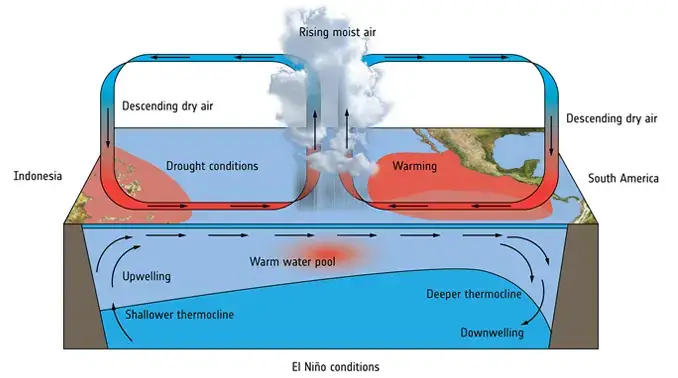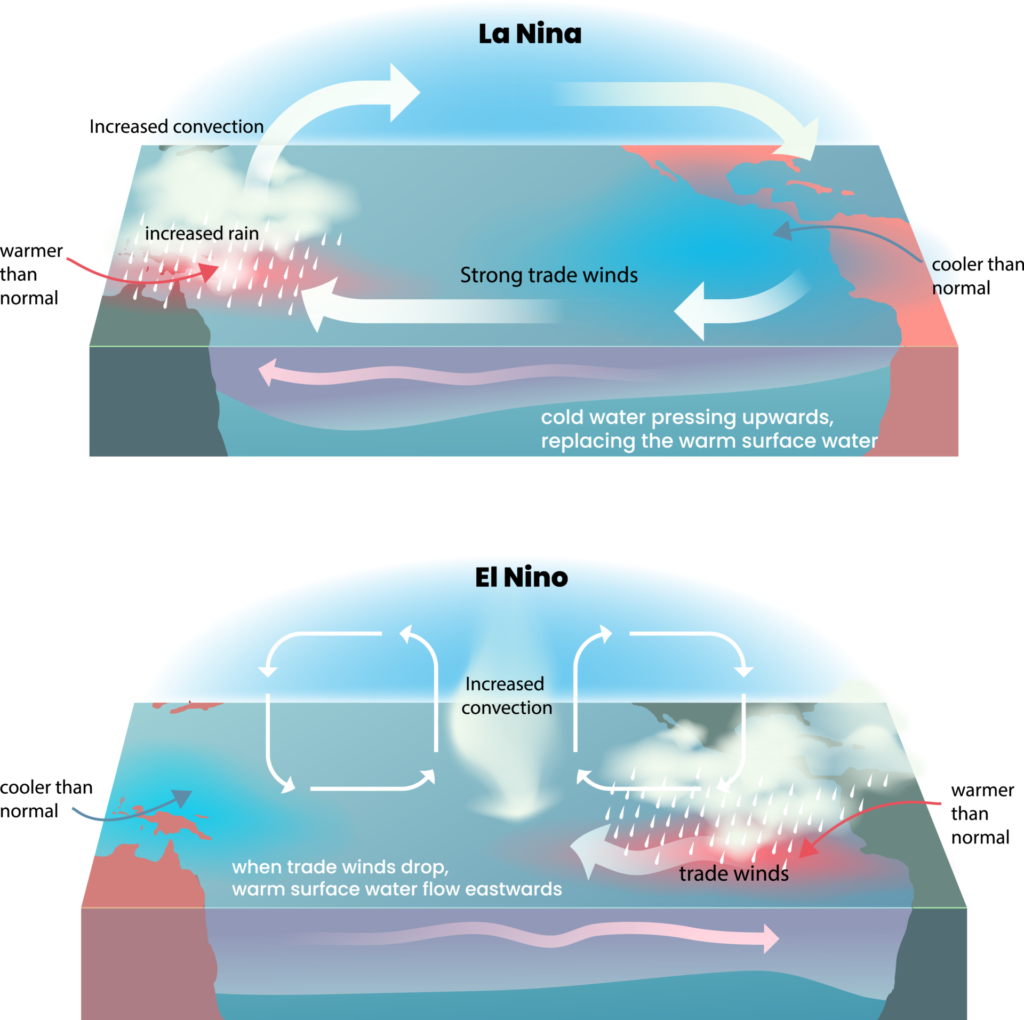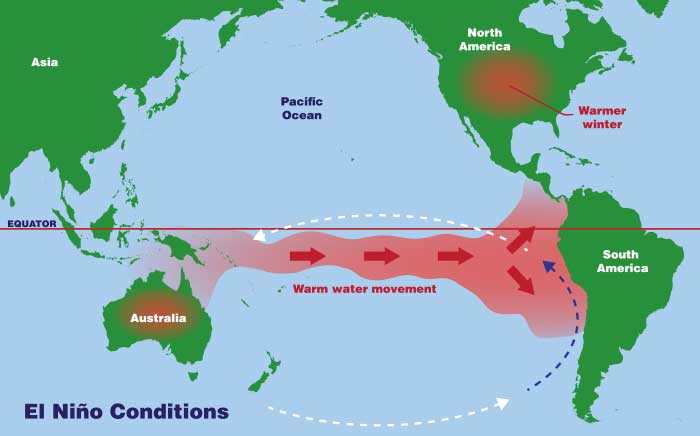Unveiling the Enigma of El Nino
Enter the fascinating realm of El Nino, an intermittent climatic phenomenon characterized by the emergence of warm ocean surface waters along the shores of Ecuador and Peru. During an El Nino episode, a symphony of atmospheric changes unfolds, redefining the usual rhythms of nature.
Pressure Shifts and the Dance of Winds

- In an El Nino year, the atmospheric script undergoes a dramatic rewrite. Air pressure plummets across vast expanses of the central Pacific and the coastal regions of South America. The conventional low-pressure regime yields a subdued high-pressure system in the western Pacific, known as the “southern oscillation.”
- This shift in pressure orchestrates a transformation of the trade winds, giving rise to a weakened Walker Cell—a key component of the atmospheric circulation system. On rare occasions, the Walker Cell may even perform an extraordinary feat by reversing its course.
- The subdued trade winds pave the way for the equatorial counter-current, a west-to-east flow within the tranquil doldrums. As this gentle current meanders along, it accumulates pockets of warm ocean water along the shores of Peru and Ecuador, replacing the customary cold embrace of the Peruvian current.
El Niño Unveiled: The Theatrical Changes
- The accumulation of this warm water has profound consequences. It leads to a drop in the thermocline—an invisible boundary within the eastern Pacific Ocean. As the thermocline descends, it severs the lifeline of cold, deep ocean water that typically upwells along the Peruvian coast. This change in the oceanic scene reverberates throughout the climate system.
Climatic Impacts: A Tale of Contrasts
- The arrival of El Niño on the climatic stage ushers in a striking array of contrasts:
- In the western Pacific, regions such as Indonesia and Northern Australia grapple with drought, as the usual rains grow scarce.
- Along the equatorial coast of South America, the arid landscape is transformed as rain comes pouring down.
- Central Pacific experiences a meteorological fiesta, marked by convective storms and hurricanes.
El Niño’s Seasonal Encore
- El Niño typically makes its entrance around Christmas, casting its climatic spell for several weeks to a few months. On occasion, an extended and exceptionally warm version of El Niño takes center stage, captivating the climate for prolonged periods. The 1990s bore witness to the dominance of robust El Niños, commencing in 1991 and enduring until 1995.
In the ever-evolving narrative of Earth’s climate, El Niño stands as a captivating act—one that leaves an indelible mark on the world’s weather patterns. With each appearance, it challenges the expected, offering a climatic performance that continues to intrigue and influence the natural world.
Difference between La Nina & El Nino

Unlocking the Enigma of ENSO
Enter the intricate realm of the El Niño Southern Oscillation (ENSO), a mesmerizing dance of ocean currents and atmospheric pressures that waltz over the Pacific Ocean. This climatic duet, comprising El Niño and the Southern Oscillation, creates harmonious or contrasting notes in Earth’s climate composition.
The Southern Oscillation’s Melodic Beat
- The Southern Oscillation orchestrates an annual rhythmic symphony, choreographing fluctuations in atmospheric pressure across the tropical Indo-Pacific region. This inter-annual oscillation influences weather patterns, ocean currents, and climatic moods.
El Niño’s Thermal Interlude
- El Niño, an essential character in this climatic ballet, emerges as a circulation of warm surface ocean currents in the Pacific Ocean. This warm water intrusion in the eastern Pacific challenges the ocean’s equilibrium, altering the climatic dynamics.
ENSO: A Unified Performance
- More often than not, El Niño and the Southern Oscillation take to the stage simultaneously, creating an ENSO ensemble. In this combined act, their effects intertwine and reverberate throughout the climate system.
Deconstructing the ENSO Ensemble
- Dissecting this climatic duo reveals its key elements:
- El Niño Solo: Characterized by warm waters in the eastern Pacific and a juxtaposition of cold waters in the western Pacific.
- Southern Oscillation Solo: With low-pressure reigning over the eastern Pacific and high-pressure dominating the western Pacific.
- ENSO Duet: ENSO results from the harmonious convergence of El Niño (warm waters in the eastern Pacific and low-pressure over the same region) and the Southern Oscillation (cold waters in the western Pacific and high-pressure dominating this territory).
In this intricate climate ballet, ENSO plays a central role, orchestrating an intricate dance of atmospheric pressures and oceanic currents. The characters, El Niño and the Southern Oscillation, seamlessly blend their performances to paint the canvas of Earth’s climate, creating a captivating and ever-changing masterpiece.
El Niño Modoki
Enter the intriguing world of El Niño Modoki, a climate phenomenon with a distinct storyline. Unlike its conventional counterpart, El Niño Modoki showcases a unique sequence of events, adding a twist to the climate narrative.
Traditional El Niño’s Character
- In the classic El Niño performance, the spotlight is on the dramatic warming of the eastern equatorial Pacific. This climatic lead character steals the show by introducing anomalies in ocean temperature.
El Niño Modoki’s Unconventional Role
- El Niño Modoki, on the other hand, is a maverick. It takes center stage with intense warming in the central tropical Pacific while simultaneously casting a cooling spell in the eastern and western tropical Pacific regions. This distinctive choreography creates an intriguing contrast.
Climate Dynamics Unveiled
- These contrasting temperature gradients set the stage for a climatic two-act play known as the Walker Circulation. Act One unfolds with a wet region dominating the central Pacific, while Act Two reveals dry conditions in the western and eastern Pacific regions.
The Impact of El Niño and ENSO
- El Niño and the broader El Niño Southern Oscillation (ENSO) phenomenon hold pivotal roles in climate monitoring and long-range forecasting worldwide. During the reign of ENSO, the world witnessed large-scale weather variations that impacted various regions.
ENSO’s Global Theatrics
- In ENSO’s strong seasons, the world becomes a stage for meteorological drama:
- The arid coastal stretches of South America transform into rain-soaked landscapes.
- California, Ecuador, the Gulf of Mexico, and China experience abundant downpours.
- Simultaneously, Australia, Indonesia, India, and southern Africa bear the weight of severe droughts.
- The warmth of ocean surface waters spells trouble for marine life off the coasts of Peru and Ecuador, leading to reduced fish catches in these regions.
Normal Conditions Unveiled
- In the world of climatic equilibrium:
The eastern Pacific along the coasts of Peru and Ecuador enjoys the cool embrace of ocean waters, creating ideal conditions for fishing. - In the western Pacific, Indonesia and Australia bask in warm ocean waters, fostering a climate of plentiful rainfall.
ENSO’s Dramatic Impact
- However, the emergence of El Niño and ENSO transforms this climatic equilibrium:
- The eastern Pacific coasts of Peru and Ecuador experience warm ocean waters, dealing a blow to the fishing industry.
- Western Pacific regions, including Indonesia and Australia, find themselves in the grip of cold ocean waters, resulting in drought conditions.
El Niño Modoki’s unconventional storyline enriches the intricate web of global climate patterns, showcasing nature’s ability to deliver climatic surprises on Earth’s grand stage.
El Niño’s Impact on Indian Monsoons: A Weather Tango
Picture a dance between the El Niño and the Indian monsoon, where their moves and rhythms create a delicate balance of climate dynamics. This meteorological performance showcases the intricate relationship between El Niño/ENSO and the monsoon in India.

The Climate Tango
- El Niño/ENSO and the Indian monsoon share an inverse relationship that shapes the monsoonal patterns. A pivotal element in this weather dance is the location of low-pressure zones and the corresponding ascending airflows. The Western Pacific, in its customary position as the hub of low-pressure systems, sets the stage for a fruitful Indian monsoon.
El Niño’s Intrusion
- During El Niño years, this well-choreographed dance takes an unexpected turn. El Niño disrupts the equilibrium by shifting the low-pressure system eastward from its typical position. This climatic interference results in a reduction of monsoon rainfall in India.
Droughts in the Spotlight
- The history of droughts in India often features El Niño droughts as the leading actors. Recent droughts, including the period from 2014 to 2016, took center stage during El Niño episodes. However, it’s important to note that not all El Niño/ENSO years lead to droughts in India.
Unpredictable Outcomes
- In the world of climate, surprises abound. For example, despite the strong El Niño of 1997-98, India managed to avoid a drought. This exception was attributed to the influence of the Indian Ocean Dipole (IOD). Conversely, the moderate El Niño of 2002 resulted in one of the most severe droughts in India.
Agriculture and the Economy
- The ramifications of El Niño’s influence on Indian monsoons extend far beyond the weather. El Niño directly affects India’s agrarian Economy by reducing the production of summer crops such as rice, sugarcane, cotton, and oilseeds. This agricultural impact ripples through the Economy, leading to high inflation rates and slower growth in the gross domestic product. Agriculture contributes substantially to the Indian Economy, accounting for approximately 14 percent of its total output.
Measuring the Weather Tango
- The Southern Oscillation Index (SOI) plays the role of a weather scorecard, measuring the intensity of the Southern Oscillation, a component of El Niño/ENSO. This index quantifies the pressure difference between Tahiti in French Polynesia (representing the Central Pacific) and Port Darwin in northern Australia (representing the Eastern Pacific). The SOI’s values, whether positive or negative, provide clues about the expected rainfall in India.
The SOI Scorecard
- Positive SOI values indicate that the pressure in Tahiti (eastern Pacific) exceeds that in Port Darwin (western Pacific). This sets the stage for drought conditions in the Eastern Pacific and bountiful rainfall in the Western Pacific, which is good news for Indian monsoons.
- In contrast, negative SOI values indicate a reversal, where the pressure in Tahiti falls below that in Port Darwin. This reversal is detrimental for Indian monsoons, as it foretells a scenario of reduced rainfall in India.
In the grand meteorological tango of El Niño and the Indian monsoon, their moves dictate the fate of India’s agricultural landscape and its economic well-being, underscoring the profound impact of climate on our lives.
The Indian Ocean Dipole Effect
In recent years, India has encountered a puzzling twist in its climatic narrative, one that departs from the traditional El Niño-Monsoon relationship. The plot thickens as we unveil the role of the Indian Ocean Dipole (IOD), an ocean-atmosphere phenomenon that introduces a captivating subplot to India’s climate story.
A Climate Balancing Act
- While El Niño and the Indian monsoon have historically danced to a familiar tune, this harmonious relationship has recently shown signs of discord. In a notable instance, the potent El Niño of 1997 failed to bring the expected drought to India. This led to a revelation—just as El Niño reigns in the Pacific, a similar seesaw ocean-atmosphere system orchestrates climate changes in the Indian Ocean. This climatic performer, known as the Indian Ocean Dipole (IOD), made its debut in 1999 and has since added complexity to the climatic narrative.
The IOD Spotlight
- The Indian Ocean Dipole (IOD) is defined by the temperature difference between two distinct areas or poles within the Indian Ocean. This polarity, like a seesaw, involves a western pole located in the Arabian Sea, representing the western Indian Ocean, and an eastern pole south of Indonesia, in the eastern Indian Ocean. Much like its Pacific counterpart, the atmospheric component of the IOD was also uncovered and christened as the Equatorial Indian Ocean Oscillation (EQUINOO), a symphony of warm waters and atmospheric pressure between the Bay of Bengal and the Arabian Sea.
IOD’s Climatic Choreography
- When the IOD assumes a positive phase, winds over the Indian Ocean blow from east to west, traveling from the Bay of Bengal towards the Arabian Sea. This weather ballet warms the Arabian Sea, transforming it into a hotspot while simultaneously cooling and drying the eastern Indian Ocean around Indonesia.
- Conversely, during a negative dipole phase, the choreography reverses, causing Indonesia to bask in warmth and heavy rainfall.
The Intriguing Impact on Monsoons
- The IOD’s presence significantly influences India’s monsoon patterns. A positive IOD index often counteracts the effects of El Niño, resulting in increased monsoon rains in several El Niño years, such as 1983, 1994, and 1997.
Cyclones in the Northern Indian Ocean
- The IOD, with its distinct phases, also exerts an intriguing influence on cyclone formation in the northern Indian Ocean. During a positive IOD phase, where the Arabian Sea takes the lead as the warmer sea, the region experiences more cyclones than usual. In contrast, a negative IOD phase enhances cyclone activity in the Bay of Bengal, while the Arabian Sea experiences suppressed cyclone formation.
The Indian Ocean Dipole, with its delicate balance of warm and cold ocean currents and atmospheric pressure, introduces a fascinating subplot to India’s climatic tale. It’s a reminder that climate systems are intricate and multifaceted, where the interactions of multiple actors can shape the destiny of monsoons, cyclones, and the lives of those they touch.
M.C.Q.
the news while forecasting the Indian monsoon, which of the following statements is/are correct? (UPSC 2017)
IOD phenomenon is characterised by a difference in sea surface temperature between tropical Western Indian Ocean and tropical Eastern Pacific Ocean.
An IOD phenomenon can influence an El Nino’s impact on the monsoon.
Select the correct answer using the code given below:
A) 1 only
B) 2 only
C) Both 1 and 2
D) Neither 1 nor 2
Answer :- B
Mains Question
Q. Most of the unusual climatic happenings are explained as an outcome of the El Nino effect. Do you agree? (UPSC 2014)

[…] For El Nino VISIT HERE […]